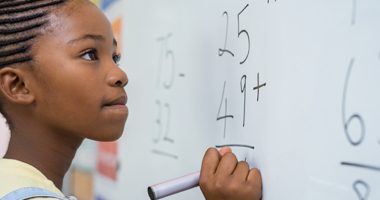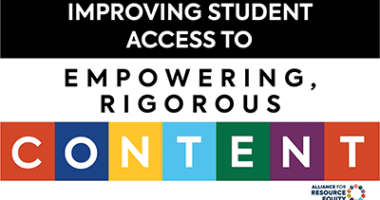Concerned About NAEP Long-Term Trend Results? There is a Path Forward
The recent NAEP long-term trend results are a concerning confirmation of the effect of unfinished learning on Black and Latino students and students from low-income backgrounds and reveal the scale of unfinished learning. While the trend results weren’t exactly unexpected, they codified the recent declines that were exacerbated by the pandemic.
The average math score is now the same as it was in 1990, while the average reading score is the same as it was in 2004. And while test scores since 2020 dropped for both math and reading across gender and racial and ethnic groups, unfinished learning has caused long-standing educational inequities. For example, compared to 2020, math scores for Native American students declined by 20 points, scores for Black students declined by 13 points, and scores for Latino students declined by 10 points, underscoring the need for schools to support these students.
Yet, parents, caregivers, and advocates cannot let doom and gloom dampen their resolve. In fact, what the results reveal is the direct path forward. Students want and deserve opportunities for the rigor and challenge of advanced coursework that engages students through culturally responsive curriculum and instruction and the support of positive school climates.
What the NAEP scores show in math
Students with opportunities for advanced mathematics coursework — students enrolled in algebra in middle school — fared better than their peers. Almost half of all 13-year-olds enrolled in algebra scored at or above level 300 (out of 500); the same is true for just 15% of students taking regular math. 8% of Black students scored at level 300 — which means schools have supported fewer than 1 in 10 Black students to be able to work with decimals, simple fractions, and common percentages, identify geometric figures, measure lengths and angles, and calculate the areas of rectangles. Yet access to advanced courses makes a difference: 20% of Black students enrolled in algebra can do the same. Similarly, 14% of all Latino students scored at level 300, but 31% of Latino students enrolled in algebra got the same score.
There was also a drop in access to advanced math. Compared to 2012, the percentage of 13-year-old students in 2023 who reported they were taking regular mathematics increased from 28% to 42%, while the percentage of students taking algebra dropped from 34 to 24%.
These findings align with research that shows students who engage in advanced coursework have increased confidence, greater academic engagement and college readiness. Yet access to and success in advanced coursework in middle school is inequitable: Black and Latino students are under-enrolled in advanced courses, due to barriers like resource inequities, racialized tracking, and limited ideas of who can be successful. These students are missing out on key opportunities that can not only set them up for success in college and careers, but also create environments that may help them stay engaged and challenged in schools.
What the NAEP scores show in reading
Students who read for fun on their own almost every day, on average, scored 13 points or more than students who reported reading less often. These frequent readers also made up the largest share of students scoring in the highest percentile. Almost half (42%) of the students scoring in the lower percentiles indicated they never or hardly ever read for fun, and students who read this infrequently scored 4 points lower than in 2020. Unfortunately, reading frequency has dropped precipitously. Only 14% of students reported reading for fun almost every day — but in 2012, it was 27%.
Students must be re-engaged through complex, affirming, and meaningful literature, but this is a major hurdle in the face of the continuing wave of book bans and gag orders. In 44 states, laws are targeting stories by and about people of color and LGBTQ+ individuals. However, all children gain immense benefits from curricula that are representationally diverse and that allow students to see themselves and others complexly. Increased engagement from representation leads to improved academic outcomes like sharpened critical thinking skills and increases in standardized test scores, as well as higher rates of course completion, graduation, and school attendance. Students reap non-academic benefits as well, such as improved self-esteem, socioemotional well-being, empathy, and a greater appreciation for cultural differences.
Whether it is by author diversity, character diversity, or the degrees to which students see themselves complexly represented, curricula do not reflect the diversity of students. And when people of color are included in curricula, they are often limited to incomplete, negative, or stereotypical portrayals. The historical and social topics that are covered in curricula are also entry points for engagement and help them grapple with real questions they have about their place in the world. Yet, when those topics are included, they are often sanitized or disconnected from student realities.
What should (and shouldn’t) be done
Many state and district leaders have responded to NAEP results by calling for grade retention or remediation — which results in students being held back a grade or given less challenging curriculum. But research consensus says that these approaches are ineffective over time, and they have the potential to lead to negative academic, social, and emotional outcomes. Ed Trust encourages school leaders to instead emphasize the more effective strategy of acceleration, where students continue with grade-level content and are instructed in key missing concepts and skills.
NAEP’s math and reading scores demonstrate precisely what must be emphasized in response to unfinished learning caused by the pandemic. Investments in children have been promising; and the best indications of investing in children will show up soon, if advocates push state and district leaders to choose the right path. At Ed Trust, we encourage decision-makers to invest in, develop, and implement evidence-based programs and practices that accelerate students’ learning and begin remedying the persistent inequities that the NAEP results confirm.










